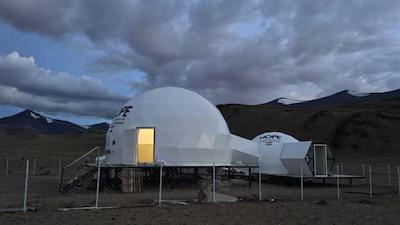
ISRO Sets Up Station in Ladakh to Simulate Life on Moon & Mars
In a significant move towards the exploration of space, the Indian Space Research Organisation (ISRO) has set up a station in Ladakh’s Tso Kar Valley to simulate life on the Moon and Mars. The Himalayan Outpost for Planetary Exploration (HOPE) is a 10-day simulation mission that will test the life-support systems for future lunar and Martian missions. The unique location of the valley, with its high UV radiation, low atmospheric pressure, and extreme cold, makes it an ideal spot to mimic the harsh conditions on the red planet.
The HOPE mission is a crucial step towards India’s ambitious plan to send humans to space in the near future. The station will be occupied by two crew members from August 1 to 10, who will undertake various tests and experiments to assess the feasibility of sustaining life on the Martian surface. The mission aims to collect valuable data on the effects of prolonged exposure to Martian conditions on the human body and the performance of life-support systems.
The Tso Kar Valley was chosen as the location for the HOPE mission due to its remarkable similarity to the Martian environment. The valley’s high altitude, low atmospheric pressure, and extreme cold temperatures create conditions that are eerily similar to those found on Mars. The Martian surface is characterized by low air pressure, extreme cold, and high UV radiation, making it a challenging environment for human exploration. The HOPE mission will help ISRO scientists to better understand the effects of these conditions on the human body and develop strategies to mitigate them.
The life-support systems that will be tested at the HOPE station include air, water, and food supplies, as well as communication equipment and medical facilities. The crew members will also conduct experiments to assess the psychological and physical effects of prolonged isolation and confinement, which are critical factors to consider when planning long-duration space missions.
The HOPE mission is a collaborative effort between ISRO and various Indian research institutions, including the Space Applications Centre, the Indian Institute of Chemical Technology, and the Defence Institute of Physiology and Allied Sciences. The mission will provide valuable insights into the challenges of space exploration and help ISRO to develop strategies for overcoming them.
India’s space program has made significant progress in recent years, with the country successfully launching several satellites and space probes. The HOPE mission is an important step towards India’s ambitious plan to send humans to space by 2022. The mission will also help India to develop its capabilities in space exploration and contribute to the global effort to explore the vastness of space.
In conclusion, the HOPE mission is a significant milestone in India’s space program, and the establishment of the Himalayan Outpost for Planetary Exploration in Ladakh’s Tso Kar Valley is a testament to ISRO’s commitment to space exploration. The mission will provide valuable insights into the challenges of space exploration and help India to develop its capabilities in this field. As we move forward in our journey to explore the cosmos, the HOPE mission is an important step towards realizing our dreams of space travel and exploration.
News Source:






